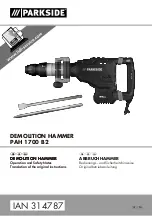
11
SECTION 4
P1350 AC POWER SUPPLY OPERATING CONSIDERATIONS
4.4
DRIVING MOTORS
(continued)
During this time the current supplied to the motor will remain sinusoidal, this allows the motor to start
rotating. Once the motor reaches it’s normal operating speed it generates the required “back EMF” and
the supply current drops off to the nominal “run” current for the motor. Ramping up the voltage to the
motor can reduce the locked rotor current demand. This will allow the AC power supply to start many
types of motors with run currents up to 10 Amps.
4.5
DRIVING NON-LINEAR LOADS
Loads utilizing rectifiers and SCRs interact with the AC power source and have a profound effect on
the distortion of the output waveform. Consider the use of a bridge rectifier followed by a capacitive
filter. The current waveform associated with this circuit is illustrated in figure 4-1. The input current to
this type of circuit is drawn in large “gulps” whenever the voltage across the capacitor falls below the
peak of the input waveform. This current is limited only by the series impedance present in the wiring
and capacitor. The impedance of large electrolytic capacitors is very small. This action causes a current
waveform with a peak value that may be several times the RMS value. This ratio of peak current to RMS
current is known as “Crest Factor”. High values of crest factor cause distortion of the AC voltage
waveform.
The amount of distortion incurred is dependant on many factors and is beyond the scope of this manual.
It should be noted that this type of load may cause the output waveform to exhibit “flat-topping” This
should not be associated with a defect of the power source. Most “real world” electric distribution
systems exhibit this distortion for this reason.
4.6
INPUT POWER REQUIREMENTS
The model P1350 utilizes a rectifier followed by a bank of filter capacitors. Because of this fact, it
presents a nonlinear load to the utility power. The’s input current waveform has a high crest factor and
contains a large amount of harmonic currents. These harmonic currents do not contribute to the output
power of the power source but must still be supplied by the input line. This adds up to a poor input
power factor.
!
WARNING
When selecting a suitable line input, it must be understood that the input current required for full output
power (1350 watts) from the P1350 may exceed 20Amps RMS. This is only true for purely resistive
loads (Watts v.s. Volt/Amperes). For this reason the unit is supplied with an IEC 320 C-20 input
receptacle. If continuous full power operation is desired, the unit must be supplied from the equivalent
20 amp-rated receptacle. The line cord (P/N 107-802-000) supplied with the unit has standard North
American NEMA 15P at one end. This was done due to the fact that it is more convenient to most end
users. Although the cord itself can handle the current, the line end should be changed to the
appropriate mate for prolonged full power operation.
Failure to do so may cause overheating of the
input
line connection
. This may cause a fire hazard. Consult with Behlman if unsure.
Full power operation into a full resistive load may cause loading ( sagging )of the supplied line voltage
if a large series impedance is present. This is due to the high current required by the model P1350. If
problems are encountered while trying to achieve full output power, monitor the input line. If the line
drops below 110VAC, move the unit to a known “stiff” line.





































